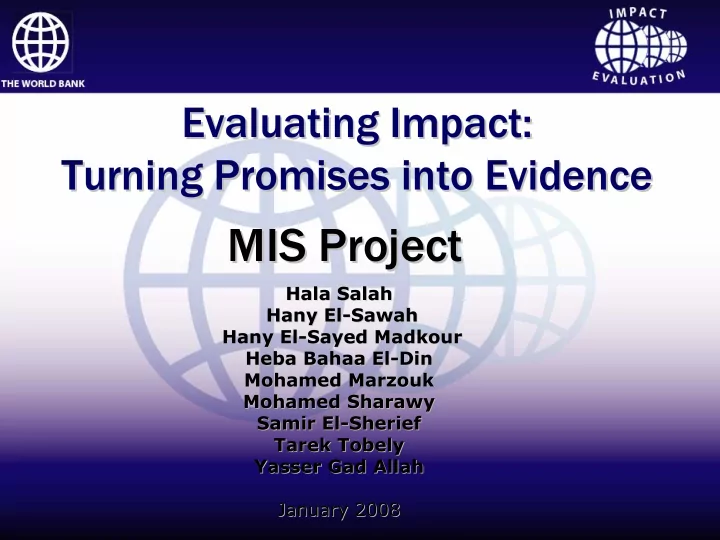

Evaluating Impact: Evaluating Impact: Evaluating Impact: Evaluating Impact: Turning Promises into Evidence Turning Promises into Evidence Turning Promises into Evidence Turning Promises into Evidence MIS Project MIS Project Hala Salah Salah Hala Hany El- -Sawah Sawah Hany El Hany El Hany El- -Sayed Sayed Madkour Madkour Heba Bahaa Bahaa El El- -Din Din Heba Mohamed Marzouk Marzouk Mohamed Mohamed Sharawy Sharawy Mohamed Samir El El- -Sherief Sherief Samir Tarek Tobely Tarek Tobely Yasser Gad Allah Yasser Gad Allah January 2008 January 2008
1. Background � Higher Education Enhancement Project HEEP � FOEP Faculty of Education Project � ETCP Egyptian Technical Colleges Project � FLDP Faculty-Leadership Development Project � QAAP Quality Assurance and Accreditation Project � HEEPF Higher Education Enhancement Project Fund � ICTP Information & Communication Technology Project 2
1. Background � Information & Communication Technology Project ICTP � Infrastructure of information Networks � Management Information System (MIS) � e-learning � Digital Libraries � ICT training 3
1. Background � Objectives of the MIS project � Establish MIS centers in 15 universities � Develop MIS application for all the Egyptian universities � Develop MIS/DSS for the SCU 4
2. Results Chain Inputs Inputs Activities Activities Outputs Outputs Outcomes Outcomes Impact Impact • Funds • Establishing • MIS Centers • Enhanced • Improved quality , MIS Centers administrative relevance , and • Data & • Reliable procedures efficiency of information • Data Entry databases higher education • Efficiency & • Human • Purchasing • Trained staff effectiveness of resources Equipment • MIS the Management Performance • Technical • Preparing MIS applications Expertise applications • Reports • Efficient decisions • Training staff • Effective strategic • System testing planning on micro and macro level & rollup 5
3. Primary Research Questions � Does the MIS project enhance the administration & management efficiency? � Does the MIS project enhance the Quality of higher education? 6
4. Outcome Indicators � Time taken to issue students’ certificates, IDs, … etc. � Time taken for a student to enroll � No. of documents (certificate, ID, … etc.) produced per unit of time � Time needed to finish students’ results � Time needed to get a student information � The adequacy and accuracy of the databases & reports � Availability of data for decision making � Staff, student, and top-management satisfaction for administrative operations � Cost effectiveness of the MIS project 7
4. Impact Indicators � The students’ average Cumulative Marks (no standardized test) � The average No. of years to finish an academic programs � The average time between graduation and employment � The right matching between the specialization and the job � The average income for the graduates � The satisfaction of the job market with the quality of the graduates 8
5. Identification Strategy/Method � Efficiency of Administrative system � Randomized roll out - 174 faculties � Quality of Education � Matched difference in differences - between 200 treated faculties and 100 faculties that chose not to participate in the program (non- treated) 9
5. Identification Strategy/Method 300 faculties Matching/ DiD 200 treated 100 not treated Faculties chose not to participate in the MIS project 26 pilot faculties 174 roll out t = 0 Randomization Phase 1: Phase 2: 87 faculties 87 faculties t = 3 t = 9 10
5. Identification Strategy/Method Randomization 0 3 6 9 months 26 pilot Phase 1: Phase 2: faculties 87 faculties 87 faculties 11
6. Sample and data � Efficiency of Administrative system � Sample � Treatment: 87 randomly selected faculties � Control: the rest of the 87 faculties � Data � Quantitative: administrative data � Qualitative data: use and satisfaction of MIS 12
6. Sample and data � Quality of Education � Matched samples � Treatment: from 200 treated faculties � Control: from non-treated 100 faculties � Data � Quantitative: administrative data � Quantitative: tracer studies of graduates 13
7. Time Frame/Work Plan � Matching based on available data: Feb. 2008 � Baseline data collection (tracer study) � Randomization � Intervention � Follow-up data collection: 2-3 rounds Tracer study Follow up data Randomization Baseline data collection 0 3 6 9 months 26 pilot Phase 1: 87 Phase 2: 87 faculties faculties faculties Intervention 14
8. Sources of Financing � MIS project � Universities (Co-finance) 15
Thank You 16
Recommend
More recommend